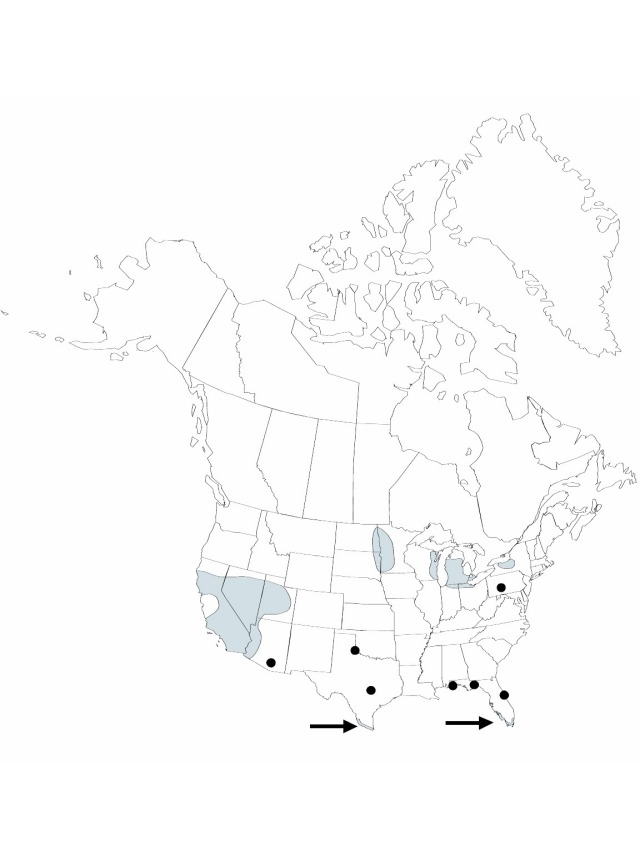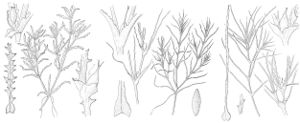Difference between revisions of "Najas marina"
Sp. Pl. 2: 1015. 1753..
FNA>Volume Importer |
imported>Volume Importer |
||
| (6 intermediate revisions by 2 users not shown) | |||
| Line 7: | Line 7: | ||
}} | }} | ||
|common_names=Spiny naiad | |common_names=Spiny naiad | ||
| + | |special_status={{Treatment/ID/Special_status | ||
| + | |code=F | ||
| + | |label=Illustrated | ||
| + | }} | ||
|basionyms= | |basionyms= | ||
|synonyms={{Treatment/ID/Synonym | |synonyms={{Treatment/ID/Synonym | ||
|name=Najas gracilis | |name=Najas gracilis | ||
|authority=(Morong) Small | |authority=(Morong) Small | ||
| + | |rank=species | ||
}} | }} | ||
|hierarchy=Najadaceae;Najas;Najas marina | |hierarchy=Najadaceae;Najas;Najas marina | ||
| Line 26: | Line 31: | ||
|elevation=0–1000 m | |elevation=0–1000 m | ||
|distribution=Ariz.;Calif.;Fla.;Ind.;Mich.;Minn.;Nev.;N.Y.;N.Dak.;Ohio;Pa.;S.Dak.;Tex.;Utah;Wis.;Mexico;West Indies;Central America (El Salvador;Panama);South America;Eurasia. | |distribution=Ariz.;Calif.;Fla.;Ind.;Mich.;Minn.;Nev.;N.Y.;N.Dak.;Ohio;Pa.;S.Dak.;Tex.;Utah;Wis.;Mexico;West Indies;Central America (El Salvador;Panama);South America;Eurasia. | ||
| − | |discussion=<p>With its prickly internodes and prickles along the abaxial surface of the leaves, Najas marina is the easiest of our Najas to recognize. Over its entire range, the species displays considerable morphologic variability (L. Triest et al. 1986), giving cause for ten subspecies to be recognized (L. Triest 1988). In North America, however, variability is relatively minor, so I am recognizing the taxon at the specific level only (R. R. Haynes 1979). The species should be studied over its entire range, utilizing a variety of approaches, to determine adequately what, if any, infraspecific taxa should be recognized.</p> | + | |discussion=<p>With its prickly internodes and prickles along the abaxial surface of the leaves, <i>Najas marina</i> is the easiest of our <i>Najas</i> to recognize. Over its entire range, the species displays considerable morphologic variability (L. Triest et al. 1986), giving cause for ten subspecies to be recognized (L. Triest 1988). In North America, however, variability is relatively minor, so I am recognizing the taxon at the specific level only (R. R. Haynes 1979). The species should be studied over its entire range, utilizing a variety of approaches, to determine adequately what, if any, infraspecific taxa should be recognized.</p> |
|tables= | |tables= | ||
|references={{Treatment/Reference | |references={{Treatment/Reference | ||
| Line 44: | Line 49: | ||
-->{{#Taxon: | -->{{#Taxon: | ||
name=Najas marina | name=Najas marina | ||
| − | |||
|authority=Linnaeus | |authority=Linnaeus | ||
|rank=species | |rank=species | ||
| Line 58: | Line 62: | ||
|publication title=Sp. Pl. | |publication title=Sp. Pl. | ||
|publication year= | |publication year= | ||
| − | |special status= | + | |special status=Illustrated |
| − | |source xml=https:// | + | |source xml=https://bitbucket.org/aafc-mbb/fna-data-curation/src/2e0870ddd59836b60bcf96646a41e87ea5a5943a/coarse_grained_fna_xml/V22/V22_492.xml |
|genus=Najas | |genus=Najas | ||
|species=Najas marina | |species=Najas marina | ||
Latest revision as of 20:31, 5 November 2020
Stems branched distally, 6–45 cm × 0.5–4 mm; internodes 0.3–11 cm, usually with prickles. Leaves spreading to ascending with age, 0.5–3.9 cm, stiff in age; sheaths 2–4.4 mm wide, apex acute; blade 0.4–4.5 mm wide, margins coarsely serrate, teeth 8–13 per side, apex acute, with 1 tooth, teeth multicellular; midvein with prickles abaxially. Flowers 1 per axil, staminate and pistillate on different plants. Staminate flowers in distal to proximal axils, 1.7–3 mm; involucral beaks 2-lobed, 0.3–0.7 mm; anthers 4-loculed, 1.7–3 mm. Pistillate flowers in distal to proximal axils, 2.5–5.7 mm; styles 1.2–1.7 mm; stigmas 3-lobed. Seeds not recurved, reddish brown, ovoid, 2.2–4.5 × 1.2–2.2 mm, apex with style situated at center; testa dull, 10–15 cell layers thick, pitted; areoles irregularly arranged, not in distinctive rows, not ladderlike, 3–4-angled, longer than broad, end walls slightly raised. 2n = 12 (Europe).
Phenology: Flowering summer–fall.
Habitat: Brackish or highly alkaline waters of ponds and lakes
Elevation: 0–1000 m
Distribution

Ariz., Calif., Fla., Ind., Mich., Minn., Nev., N.Y., N.Dak., Ohio, Pa., S.Dak., Tex., Utah, Wis., Mexico, West Indies, Central America (El Salvador, Panama), South America, Eurasia.
Discussion
With its prickly internodes and prickles along the abaxial surface of the leaves, Najas marina is the easiest of our Najas to recognize. Over its entire range, the species displays considerable morphologic variability (L. Triest et al. 1986), giving cause for ten subspecies to be recognized (L. Triest 1988). In North America, however, variability is relatively minor, so I am recognizing the taxon at the specific level only (R. R. Haynes 1979). The species should be studied over its entire range, utilizing a variety of approaches, to determine adequately what, if any, infraspecific taxa should be recognized.
